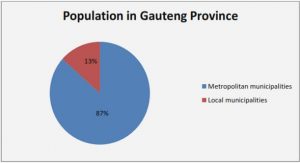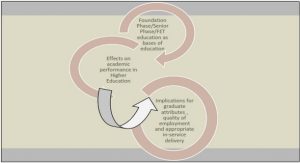Get Complete Project Material File(s) Now! »
The Case for Situated Learning for Analysing the Collaborative Redesign effort
This study is concerned with learning at work or in practice, the practice in this case being ISD. I have therefore chosen to take the social / situated learning view to learning as it affords me the opportunity to study learning as an integral part of what we do when developing systems. My concerns as articulated in the introductory chapter are centred on meanings people make as they are engaged in practice, not divorced from it. This unity in the way in which I conceptualise learning therefore points to the use or adoption of situated learning theories for this study.
Situated practice based learning theories grew out of the desire to address, mainly, the dichotomy presented by traditional theories that separate the mind from human action or behaviour. The major premise for these (situated learning) theories is that it is not possible to separate a person’s acting from the social environment of the activity itself (Rogoff and Lave, 1984; Lave, 1988; Brown and Duguid, 1991; Chaiklin and Lave, 1993; Lave, 1996; Schulz, 2005). The concern of situated learning theorists is with everyday activity as a social and historical process. They therefore view relations among person, activity, and situation, as a single encompassing theoretical entity – as the unit of analysis (Lave & Wenger 1991, 1996, Engeström (1990, 2001), Brown and Duguid (1991). They argue that situated activity involves changes in knowledge (or knowing) and action, and this is the cornerstone of learning. When we study and analyse peoples involvement in practical action in the world, as this research study is doing, we therefore analyse learning. Learning is therefore considered as participation in practice (Brown and Duguid, 1991; Lave 1993, 1996).
Common premises among situated theorists are based on their disagreement with four specific positions offered mainly by the most dominant learning theory, i.e. cognitive theory (Lave 1993; Brown and Duguid, 1991; Schulz 2005). The first and main issue, as mentioned earlier, deals with the separation of learning from other forms of activity and thus the distinction between learning and development. The cognitive theorist’s epistemology is that learning precedes development and that knowledge is a collection of real entities, located in people’s heads, and that learning is a process of internalising those entities. Situated learning theorists find this position very difficult to explain, because it assumes that ‘… actors’ relations with knowledge-inactivity are static and do not change except when subject to special periods of “learning” or “development”’ (Lave, 1993, p. 12). Their view is that knowing and learning is engagement in changing processes of human activity – learning cannot be separated from development since they occur together.
The second issue concerns the limited view about learning being transmission or transfer or internalisation of existing knowledge with no reference to how new knowledge is created and what constitutes “knowing” at any given point and in varying environments and situations. If learning is simply a transfer of knowledge then how does one explain knowledge creation during active engagement in activity? There is ample evidence in literature that knowledge is created during activity (Lave, 1993; Engeström, 1993; Keller & Keller, 1993; Suchman and Trigg, 1993). The major idea behind Vygotsky’s (1978) concept of the zone of proximal development is that people can learn to do things beyond their ‘developmental stage’ through assistance or collaborative efforts rather than individual action and that the collaborative ‘doing’ may result in something completely new.
Two representative practice based theories
In this section I provide a brief theoretical discussion on two representative practice based theories i.e. Lave & Wenger’s (1991) Legitimate Participation Practice (LPP) model and Engeström’s (1987) activity theory based model of expansive learning. The selection is based on the fact that they are the two most prominent in current discourse on practice based learning (Brown and Duguid (1991), Virkkunen and Kuutti (2000), Lave (1996), Engeström (2001), Jarviari & Poikela (2001), (Bould (2001, 2003), Billet, Bould & Solomon (2003), Bould and Middleton (2003), Schulz (2005), Daniel et al., (2007), Hill et al., (2007), Engestrom and Sannino (2010), and that they offer interesting alternatives to studying learning in practice.
Furthermore, though both are based on Vygotsky’s concept of mediation and agree on the concept of collective as opposed to individual activity, they offer contrasting and interesting views on the unit of analysis i.e. community of practice vs. network of activities. Engeström (2001) provides useful guiding questions to structure the generic understanding of theories on learning. I have adopted these questions for the theoretical review of the two learning theories i.e. Lave & Wenger’s LPP theory and Engeström’s expansive learning model. The questions that will guide the discussion are, therefore, as follows:
(1) What is learning according to the theory?
(2) Who is learning?
(3) What triggers the learning – Why are they learning?
(4) What is learned or what is the content of learning?
(5) How do they learn – How is learning achieved?
1 INTRODUCTION AND SCOPE OF THE RESEARCH
1.1 Introduction
1.2 Botswana ISD Practice as context to the Research
1.3 Research motivation, problem statement and questions
1.4 Research design and methodology
1.5 Contribution of this research
1.6 Chapter and Content Analysis
2 THEORETICAL UNDERPINNING – CULTURAL-HISTOICAL ACTIVITY THEORY
2.1 Introduction
2.2 Activity Theory History
2.3 Activity Theory – Key Principles
2.4 Conclusion
3 LITERATURE REVIEW ON ISD PRACTICE AND LEARNING
3.1 Introduction
3.2 An Activity based view of Information Systems Development (ISD)
3.3 Learning
3.4 Conclusion
4 RESEARCH DESIGN, METHODOLOGY AND DATA
4.1 Research Design Framework
4.2 Research Questions and the Unit of Analysis
4.3 Data Collection
5 CURRENT BOTSWANA ISD PRACTICE
5.1 Introduction
5.2 The Current Botswana ISD Practice Model
5.3 The Case Project
5.4 Conclusion
6 COLLABORATION IN ISD PRACTICE REVIEW AND REDESIGN
6.1 Introduction
6.2 Learning action 1 – Questioning
6.3 Learning action 2 – Analyses of Historicity, Contradictions, and Learning
6.4 Learning action 3 – Modeling the new solution
6.5 Learning action 4 – Examining the new model
6.6 Conclusion
7 CONCLUSION AND FINAL THOUGHTS
7.1 Introduction
7.2 Evaluation of Contribution
7.3 Methodological Contribution
7.4 Research Limitations and Opportunities for Future Research
7.5 Final Thoughts
References and Bibliography






